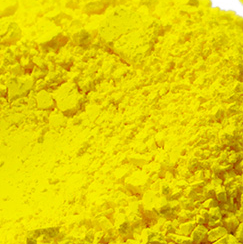| "Descrizione" by Ark90 (12431 pt) | 2024-May-26 10:08 |
Review Consensus: 10 Rating: 10 Number of users: 1
| Evaluation | N. Experts | Evaluation | N. Experts |
|---|---|---|---|
| 1 | 6 | ||
| 2 | 7 | ||
| 3 | 8 | ||
| 4 | 9 | ||
| 5 | 10 |
Quinoline Yellow is a chemical compound, derived from quinophthalone, a dye used in a variety of industries:
- Food
- Cosmetics. Nail polishes, cold soaps, liquid detergents.
- Pharmaceuticals. Tablets
- Textile. Fabrics
- Plastic
- etc
It is also used to add color to non-food producing animal feed at a maximum dose of 500 mg/kg of feed.
Labeled with the number E104 in the list of European food color additives and internationally known as CI 47005.
Safety
Regulatory data on the genotoxicity and/or mutagenicity of this compound are still controversial. This study finds that, even with in vitro testing, this dye could cause harmful effects in humans if it is metabolized or absorbed through the skin (1).

Typical optimum characteristics of the commercial colour Chinoline Yellow
| Colour Index n | 47005 |
| Food colour n. | Yellow 13 |
| F.D. & C. No. | Yellow 10 |
| Volatile matter (chloride and sulfate) Max | 30% |
| Solubility in water at 20°C | 120g/l |
| Combined ether extract. Max | 0.20% |
| Insoluble in water. Max | 0.20% |
| Class | Xanthene |
| Light stability | 4 |
| Stability at 100°C | 4 |
| Alkali stability | 4 |
| Subsidiary dyes. Max | 1.50% |
| Intermediate dyes. Max | 0.50% |
| Lead | <10ppm |
| Arsenic | <3ppm |
| Mercury | <1ppm |
| Heavy Metals | <20ppm |
 |  |
 |  |
- Molecular Formula : C18H9NNa2O8S2
- Molecular Weight : 477.369 g/mol
- CAS : 100208-62-6 8004-92-0
- EC Number 616-849-0
- UNII 35SW5USQ3G
- InChI=1S/C18H11NO8S2.2Na/c20-17-11-3-1-2-4-12(11)18(21)15(17)13-6-5-9-7-10(28(22,23)24)8-14(16(9)19-13)29(25,26)27;;/h1-8,15H,(H,22,23,24)(H,25,26,27);;/q;2*+1/p-2
- InChl Key FZUOVNMHEAPVBW-UHFFFAOYSA-L
- SMILES C1=CC=C2C(=C1)C(=O)C(C2=O)C3=NC4=C(C=C(C=C4C=C3)S(=O)(=O)[O-])S(=O)(=O)[O-].[Na+].[Na+]
- IUPAC disodium;2-(1,3-dioxoinden-2-yl)quinoline-6,8-disulfonate
- DSSTox Substance ID DTXSID0041721 DTXSID70873122
- NACRES NA.47
Synonyms :
- CI 47005
- E104
- Acid Yellow 3
- Yellow 13
- Yellow 10
- Lemon Yellow ZN 3
- Quinoline Yellow S
- Quinoline yellow WS
- Sodium 2-(1,3-dioxo-2,3-dihydro-1H-inden-2-yl)quinoline-6,8-disulfonate
- 2-(2-Quinolyl)-1,3-indandione disulfonic acid disodium salt
- dipotassium 2-(1,3-dioxo-2H-inden-2-yl)quinoline-6,8-disulfonate
- disodium 2-(1,3-dioxo-2H-inden-2-yl)quinoline-6,8-disulfonate
- 2-(1,3-Dioxoindan-2-yl)quinoline-6,8-bis(sulfonic acid sodium) salt
- disodium 2-(1,3-dioxo-2,3-dihydro-1h-inden-2-yl)-6,8-quinolinedisulfonate
- disodium 2-(1,3-dioxo-2,3-dihydro-1H-inden-2-yl)quinoline-6,8-disulfonate
References______________________________________________________________
(1) Chequer FM, Venâncio Vde P, de Souza Prado MR, Campos da Silva e Cunha Junior LR, Lizier TM, Zanoni MV, Rodríguez Burbano R, Bianchi ML, Antunes LM. The cosmetic dye quinoline yellow causes DNA damage in vitro. Mutat Res Genet Toxicol Environ Mutagen. 2015 Jan 1;777:54-61. doi: 10.1016/j.mrgentox.2014.11.003.
Macioszek VK, Kononowicz AK. The evaluation of the genotoxicity of two commonly used food colors: Quinoline Yellow (E 104) and Brilliant Black BN (E 151). Cell Mol Biol Lett. 2004;9(1):107-22.
Abstract. Additives, especially colors, are in widespread use in the food industry. With the exception of the quinolines, food colors are relatively weak mutagens and are certified as safe additives despite reports that some people have allergic reactions to them. The number of food additives is still on the increase, and research on their potential mutagenic/carcinogenic activity in vivo is very expensive. Using two different cellular model systems, human lymphocytes in vitro and Vicia faba root tip meristems of in vivo, we evaluated the potential cytological and genotoxic effects of two dyes: Quinoline Yellow (E 104) and Brilliant Black BN (E 151). Two relatively new, very sensitive and rapid tests - the micronucleus and Comet assays - were used in this study. The data provided in this paper showed the genotoxic effects of the two analyzed food colors, and confirmed the diagnostic value of the MN and Comet assays for screening potentially genotoxic substances.
| Evaluate |

